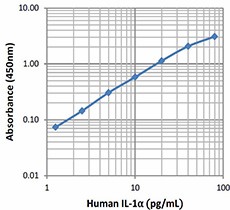- Regulatory Status
- RUO
- Other Names
- Interleukin-1α, LAF, EP, LEM, MCF/MNCF, IL-1α Precoated ELISA Kit
- Ave. Rating
- Submit a Review
- Product Citations
- publications

Interleukin-1 (IL-1) refers to two proteins, IL-1α and IL-1β, which are from different gene products. IL-1α and IL-1β share about 25% amino acid sequence identity. They are initially synthesized as 31 kD precursors, and then cleaved by proteases into mature proteins with molecular mass approximately of 17 kD.
IL-1 binds to both forms of the cell surface type I (IL-1RI) and type II (IL-1RII) IL-1 receptors. IL-1RI is expressed on T cells, fibroblasts, keratinocytes, endothelial cells, synovial lining cells, chondrocytes, and hepatocytes while IL-1RII is found on B-cell lineages, neutrophils, and bone marrow cells. Although both IL-1α and IL-1β are recognized by IL-1RI and IL-1RII receptors, IL-1α binds better to the type I receptor than IL-1β and vice versa.
IL-1 has different biological properties such as immunologic, pro-inflammatory, and protective effects. An increase of IL-1 by a variety of cells is a good indicator of infection by microbial toxins and inflammatory processes. It also affects B cell activation, immunocompetent cells and other immunologic cells. Studies show that the production of IL-1 has been detected in human joint fluids from patients with rheumatoid arthritis, osteoarthritis, traumatic arthritis, and psoriatic arthritis. In addition, IL-1α shows elevated levels in cancer such as colon cancer and cervical cancer.
The BioLegend LEGEND MAX™ Human IL-1α Sandwich Enzyme-Linked Immunosorbent Assay (ELISA) kit includes a 96-well strip plate that is pre-coated with a mouse monoclonal anti-human IL-1α capture antibody. The detection antibody is a biotinylated goat polyclonal anti-human IL-1α antibody. This kit is specifically designed for the accurate quantitation of human IL-1α from cell culture supernatant, serum, and plasma. It is analytically validated with ready-to-use reagents.
Kit Contents
- Kit Contents
-
- Anti-Human IL-1α Pre-coated 96-well Strip Microplate
- Human IL-1α Dectection Antibody
- Human IL-1α Standard
- Avidin-HRP
- Assay Buffer D
- Matrix G (for EDTA plasma samples only)
- Wash Buffer (20X)
- Substrate Solution F
- Stop Solution
- Plate Sealers
Product Details
- Verified Reactivity
- Human
- Application
-
ELISA
- Product Citations
-
- Sensitivity
- 0.25 pg/mL ± 0.08 pg/mL
- Standard Range
- 1.25-80 pg/mL
- Materials Not Included
-
- Microplate reader able to measure absorbance at 450 nm
- Adjustable pipettes to measure volumes ranging from 1 µL to 1,000 µL
- Deionized water
- Wash bottle or automated microplate washer
- Log-Log graph paper or software for data analysis
- Tubes to prepare standard dilutions
- Timer
- Plate Shaker
- Polypropylene vials
Antigen Details
- Cell Sources
- Macrophage
- Biology Area
- Cell Biology, Immunology, Innate Immunity, Neuroinflammation, Neuroscience
- Molecular Family
- Cytokines/Chemokines
- Gene ID
- 3552 View all products for this Gene ID
- UniProt
- View information about IL-1alpha on UniProt.org
Related FAQs
- In your LEGEND MAX™ ELISA Kits, there is a step that calls for washing the plates before adding sample. What is the purpose of this step?
-
We typically use a stabilizer for pre-coated plates. The additional washing step is designed to remove these components before you start the assay. If you do not perform the washing, the effect on assay performance is negligible.
- I have multiple LEGEND MAX™ ELISA kits that I want to run simultaneously. Can I use the same wash buffer for all the kits?
-
The wash buffer provided in all our LEGEND MAX™ kits is the same and the part numbers on the wash buffer bottles in these kits should be identical. For ELISA MAX™ Deluxe and ELISA MAX™ Standard Sets, we provide a recipe for the wash buffer on each kit’s technical data sheet. This recipe is the same for all ELISA MAX™ sets.
- For some of your ELISA kits, why do my serum samples require dilution with assay buffer?
-
In some cases, dilution with assay buffer is required to minimize the matrix difference between the samples and the standards to achieve better accuracy.









Follow Us